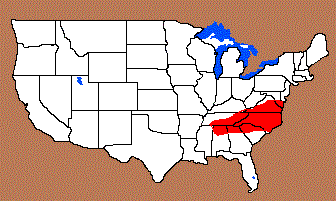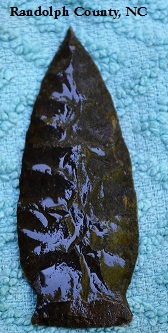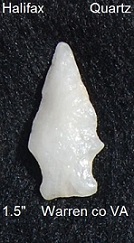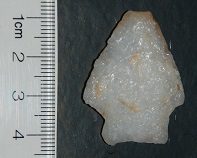Outline is Representative of Size and Shape:

Name Details:
Identified By: Joffre L. Coe
Named For: Type site area
Date Identified: 1964
Type Site: Gaston Site, Roanoke River, North Carolina
Identified By: Joffre L. Coe
Named For: Type site area
Date Identified: 1964
Type Site: Gaston Site, Roanoke River, North Carolina
Point Validity:
Valid type
Coe was a highly respected and pioneering anthropologist in North Carolina archaeology and a preeminent authority on eastern North American anthropology. This type was named in a professional publication and has many professional references. This is considered a valid type.
Halifax Notched
Cluster: Description of Physical Characteristics and Flaking Pattern:
This is a thick small to medium (1 to 2.125 inch) triangular expanding stem point with an elliptical cross section. The blade is primarily straight, but may range to excurvate with the widest part of the blade occurring about two thirds the way from the tip. Parallel notches enter the low on the blade forming a shoulder that is at an upward angle and a short expanding stem. Notches start at the widest portion of the point and extend to the base of the point. The base may vary from straight to convex. Hafting region grinding is usually present on this point. The location and depth of the notches may create an asymmetrical appearance. Many times, one shoulder may sit higher than the other. This point has a random flaking pattern.
Size Measurements:
Total Length- 29 to 56 mm (44 mm average), Stem Length - 5 to 9 mm, Blade Width - 17 to 25 mm (20 mm average), Base Width - slightly narrower than shoulders, Neck Width - 13 to 21 mm, Thickness - 8 to 11 mm
Total Length- 29 to 56 mm (44 mm average), Stem Length - 5 to 9 mm, Blade Width - 17 to 25 mm (20 mm average), Base Width - slightly narrower than shoulders, Neck Width - 13 to 21 mm, Thickness - 8 to 11 mm
Commonly Utilized Material:
quartz, quartzite, rhyolite, chert
quartz, quartzite, rhyolite, chert
Additional Comments:
Coe (1959) suggest that this point may be related to the Lamoka point from the New York area. Cambron (1964) interprets this as this point being ancestral to the Lamoka point.
These points are commonly made of quartz (Schroder, 2012 W18).
At the Gaston site, this point is found above Guilford points and below Savannah River points.
Coe (1959) suggest that this point may be related to the Lamoka point from the New York area. Cambron (1964) interprets this as this point being ancestral to the Lamoka point.
These points are commonly made of quartz (Schroder, 2012 W18).
At the Gaston site, this point is found above Guilford points and below Savannah River points.
Distribution:
Distribution Comments:
This point is primarily found in the Roanoke River Valley in North Carolina and Virginia. This point is found into Maryland. This point is found with decreased frequency into the Tennessee River Valley.
This point is primarily found in the Roanoke River Valley in North Carolina and Virginia. This point is found into Maryland. This point is found with decreased frequency into the Tennessee River Valley.
Age / Periods:
Date: 5,500 - 4,500 B.P.
Cultural Period: Middle to Late Archaic
Glacial Period: Middle Holocene
Culture:
Tradition: Narrow Point Tradition
Date: 5,500 - 4,500 B.P.
Cultural Period: Middle to Late Archaic
Glacial Period: Middle Holocene
Culture:
Tradition: Narrow Point Tradition
Age Details:
Other points in this cluster / Related / Associated Points:






